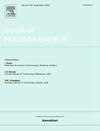NURBS-enhanced finite element spatial discretisation methods for the steady-state multigroup neutron diffusion equation
IF 2.3
3区 工程技术
Q1 NUCLEAR SCIENCE & TECHNOLOGY
引用次数: 0
Abstract
The NURBS-enhanced finite element method (NEFEM) is a recent innovation in spatial discretisation methods. The NEFEM combines the conventional FEM with computer-aided geometric design (CAGD) boundary representation (B-rep) approaches based upon Non-Uniform Rational B-spline (NURBS) geometrical representations of the computational domain. The aim of the NEFEM is to streamline the CAGD to computer-aided engineering (CAE) modelling and simulation (M&S) pipeline and provide improved geometrical representations of the underlying curvilinear geometry in nuclear reactor physics and reactor shielding simulations. This eliminates the requirement for local modifications to the underlying computational mesh to preserve the surface areas and volumes of curvilinear geometrical features within the computational domain. Such local mesh modifications are required, within conventional isoparametric Lagrangian FEM approaches, to preserve fissile mass and neutron leakage within curvilinear geometrical and computational domains.
This paper presents the application of the NEFEM to the multigroup neutron diffusion equation (NDE) for three nuclear reactor physics benchmark verification test cases. A further method of manufactured solution (MMS) benchmark verification test case is used to establish the order of convergence of the NEFEM compared to the FEM for both linear and quadratic elements. In addition, an analytical Wigner–Seitz pincell problem is used to further investigate the accuracy of the NEFEM. The results from these benchmark verification test cases demonstrate that the NEFEM yields improved numerical accuracy compared to the conventional FEM. This improved numerical accuracy is primarily achieved through the improved geometrical representation of curvilinear geometries. While the NURBS-enhancement of elements necessitates a small increase to the pre-processing time associated with the method, the increased accuracy of the NEFEM allows it to achieve competitive computational solution times compared to the standard Lagrangian FEM.
稳态多群中子扩散方程的nurbs增强有限元空间离散化方法
nurbs增强有限元法(NEFEM)是空间离散化方法的最新创新。NEFEM将传统有限元法与基于非均匀有理b样条(NURBS)几何表示的计算机辅助几何设计(CAGD)边界表示(B-rep)方法相结合。NEFEM的目的是将CAGD简化为计算机辅助工程(CAE)建模和仿真(M&;S)管道,并提供核反应堆物理和反应堆屏蔽模拟中潜在曲线几何的改进几何表示。这消除了对底层计算网格进行局部修改的要求,以保持计算域内曲线几何特征的表面积和体积。在传统的等参数拉格朗日有限元方法中,需要进行这样的局部网格修改,以将裂变质量和中子泄漏保持在曲线几何和计算域内。本文介绍了NEFEM在三个核反应堆物理基准验证试验用例多群中子扩散方程(NDE)中的应用。进一步采用制造解(MMS)基准验证试验例的方法,确定了NEFEM相对于线性单元和二次元有限元的收敛阶数。此外,还采用了解析型Wigner-Seitz pincell问题来进一步研究NEFEM的精度。这些基准验证用例的结果表明,与传统有限元法相比,NEFEM具有更高的数值精度。这种改进的数值精度主要是通过改进曲线几何的几何表示来实现的。虽然元件的nurbs增强需要少量增加与该方法相关的预处理时间,但与标准拉格朗日有限元法相比,NEFEM精度的提高使其能够实现具有竞争力的计算求解时间。
本文章由计算机程序翻译,如有差异,请以英文原文为准。
求助全文
约1分钟内获得全文
求助全文
来源期刊

Annals of Nuclear Energy
工程技术-核科学技术
CiteScore
4.30
自引率
21.10%
发文量
632
审稿时长
7.3 months
期刊介绍:
Annals of Nuclear Energy provides an international medium for the communication of original research, ideas and developments in all areas of the field of nuclear energy science and technology. Its scope embraces nuclear fuel reserves, fuel cycles and cost, materials, processing, system and component technology (fission only), design and optimization, direct conversion of nuclear energy sources, environmental control, reactor physics, heat transfer and fluid dynamics, structural analysis, fuel management, future developments, nuclear fuel and safety, nuclear aerosol, neutron physics, computer technology (both software and hardware), risk assessment, radioactive waste disposal and reactor thermal hydraulics. Papers submitted to Annals need to demonstrate a clear link to nuclear power generation/nuclear engineering. Papers which deal with pure nuclear physics, pure health physics, imaging, or attenuation and shielding properties of concretes and various geological materials are not within the scope of the journal. Also, papers that deal with policy or economics are not within the scope of the journal.
 求助内容:
求助内容: 应助结果提醒方式:
应助结果提醒方式:


